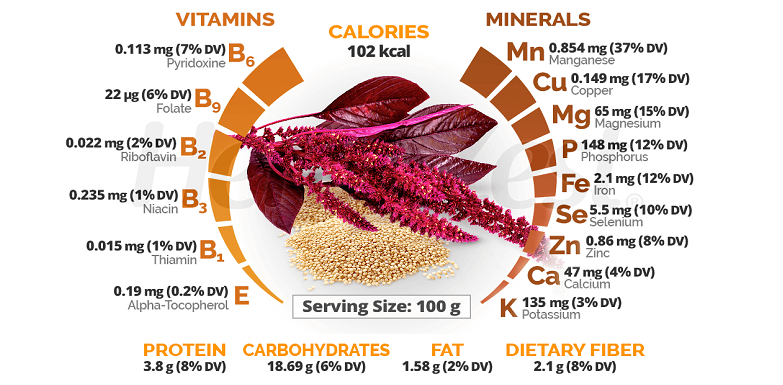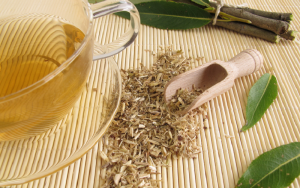
Amaranth is an ancient pseudocereal with a rich history and impressive health benefits. Amaranth is often overshadowed by more popular grains like quinoa and rice, but it is finally making a comeback in the modern culinary scene. This nutrient-dense powerhouse, packed with vitamins, minerals, and high-quality protein, offers a unique combination of health benefits that make it a fantastic addition to any diet.
Contents
Introduction to Amaranth
Amaranth, a lesser-known pseudocereal with a rich history and an array of health benefits, is gradually gaining popularity in the modern culinary world. Before we delve into the wonders of amaranth, let’s first understand what a pseudocereal is and how it differs from true cereals.
Defining Pseudocereals
Pseudocereals are non-grass plants that produce edible seeds, which are used in much the same way as cereal grains. While they are not true cereals, which come from the grass family, they share similar nutritional profiles and culinary uses. Some well-known pseudocereals include quinoa, buckwheat, and, of course, amaranth.
History of Amaranth Cultivation
Amaranth has a long and fascinating history, dating back over 8,000 years. It was a staple food for the Aztecs, who believed it possessed supernatural powers and used it in various religious ceremonies. They cultivated amaranth alongside maize and beans, forming a trio of essential crops in their culture. However, the Spanish conquest led to the decline of amaranth, as the Spanish authorities actively discouraged its cultivation due to its association with indigenous rituals [1].
Revival of Amaranth in Modern Diets
In recent years, there has been a resurgence of interest in amaranth, driven by its impressive nutritional profile and potential health benefits. Researchers, health enthusiasts, and chefs alike have turned their attention to this ancient grain, exploring its unique properties and incorporating it into modern dishes. As a result, amaranth is making a comeback and is now becoming more accessible in supermarkets and health food stores worldwide.

Nutritional Profile of Amaranth
One of the reasons for amaranth’s resurgence in popularity is its remarkable nutritional profile. This ancient pseudocereal is packed with essential nutrients that contribute to its numerous health benefits.
Macronutrients and Calorie Content
Amaranth is a nutrient-dense food, providing a good balance of carbohydrates, protein, and healthy fats. One cup (246 grams) of cooked amaranth contains approximately 251 calories, 46 grams of carbohydrates, 9 grams of protein, and 4 grams of fat. The majority of its fat content comes from healthy unsaturated fats, including omega-3 and omega-6 fatty acids, which are known for their heart-healthy properties [2].
Vitamins and Minerals
Amaranth is an excellent source of several essential vitamins and minerals, including magnesium, phosphorus, iron, and manganese. It also contains notable amounts of calcium, potassium, zinc, and vitamins B1, B2, B3, B5, and B6. These nutrients play crucial roles in various bodily functions, such as energy production, immune function, and bone health.
Protein and Amino Acid Composition
Amaranth is particularly impressive when it comes to protein content. It boasts a higher protein content than most other grains and is considered a complete protein, meaning it contains all nine essential amino acids. This makes amaranth an excellent choice for vegetarians, vegans, and anyone looking to diversify their protein sources.
Fiber Content and Benefits
In addition to its impressive protein content, amaranth is also rich in dietary fiber. One cup of cooked amaranth provides about 5 grams of fiber, which is roughly 20% of the recommended daily intake for most adults. Consuming adequate amounts of fiber is essential for maintaining good digestive health, preventing constipation, and promoting a healthy gut microbiome. Moreover, fiber-rich foods like amaranth can help with weight management, as they provide a feeling of fullness and help regulate blood sugar levels.

Health Benefits of Amaranth
The nutritional profile of amaranth lends itself to a range of health benefits that make this ancient pseudocereal a valuable addition to any diet. In this section, we’ll explore the anti-inflammatory properties, antioxidant effects, gluten-free nature, heart health support, blood sugar management, and bone health promotion associated with amaranth consumption.
Anti-Inflammatory Properties
Amaranth contains several bioactive compounds with anti-inflammatory properties, such as lunasin, peptides, and phenolic compounds. These substances can help reduce inflammation in the body, which is linked to numerous chronic diseases, including heart disease, cancer, and diabetes. Incorporating amaranth into your diet may contribute to overall better health by combating inflammation [3].
Antioxidant Effects
Amaranth is a rich source of antioxidants, including flavonoids and phenolic acids. Antioxidants play a crucial role in neutralizing free radicals, which can cause cellular damage and contribute to aging and various diseases. The antioxidant content of amaranth can help protect your body from oxidative stress and support overall health.
Gluten-Free Alternative
Amaranth is a naturally gluten-free pseudocereal, making it an excellent choice for individuals with celiac disease or gluten sensitivity. For those looking to diversify their gluten-free options beyond rice and corn, amaranth offers a nutrient-dense and versatile alternative.
Support for Heart Health
The high fiber, protein, and healthy fat content of amaranth make it a heart-healthy food. Fiber helps to lower LDL (“bad”) cholesterol levels, while the omega-3 and omega-6 fatty acids found in amaranth may help reduce inflammation and support cardiovascular health. Additionally, the magnesium content in amaranth can aid in maintaining healthy blood pressure levels [4].
Role in Blood Sugar Management
Amaranth’s high fiber content can help regulate blood sugar levels by slowing down the absorption of glucose into the bloodstream. This makes it a suitable food choice for individuals with diabetes or those at risk of developing the condition. The protein content in amaranth also contributes to better blood sugar management by promoting satiety and reducing the risk of overeating.
Bone Health and Calcium Absorption
Amaranth is a good source of calcium, magnesium, and phosphorus – all essential nutrients for maintaining strong bones and teeth. Moreover, the presence of lysine, an essential amino acid, in amaranth can help improve calcium absorption and retention, further supporting bone health. Including amaranth in your diet can contribute to better bone health and potentially reduce the risk of osteoporosis [5].

Cooking with Amaranth
Now that we’ve explored the impressive nutritional profile and health benefits of amaranth, it’s time to learn how to incorporate this ancient pseudocereal into your culinary repertoire. In this section, we’ll discuss the various ways to prepare amaranth grains, the uses of amaranth flour, and the incorporation of amaranth leaves into your dishes.
Preparing Amaranth Grains
Amaranth grains can be cooked using different methods, depending on the desired texture and culinary application. Two common methods for preparing amaranth grains are boiling and popping.
Boiling Method
To cook amaranth grains using the boiling method, start by rinsing the grains thoroughly under cold water. Combine one part amaranth with two parts water in a saucepan and bring to a boil. Reduce the heat, cover, and let it simmer for 20-25 minutes, or until the grains are tender and have absorbed most of the water. The cooked amaranth will have a slightly sticky texture, making it perfect for dishes like porridge, salads, or as a side dish.
Popping Method
Popping amaranth is similar to popping popcorn and results in a light, crunchy texture. To pop amaranth grains, heat a dry, heavy-bottomed skillet or saucepan over medium-high heat. Add a small amount of amaranth (about 1-2 tablespoons) to the hot pan and cover with a lid. Shake the pan continuously to ensure even heating and prevent burning. The amaranth grains should begin to pop within a few seconds. Once the popping slows down, remove the pan from heat and transfer the popped amaranth to a bowl. Use the popped amaranth as a topping for yogurt, oatmeal, or salads, or incorporate it into energy bars and granola.
Amaranth Flour Uses
Amaranth flour, made from ground amaranth grains, is a versatile gluten-free alternative to wheat flour. Here are a couple of ways to use amaranth flour in your kitchen:
Baking
Amaranth flour can be used to make a variety of baked goods, such as bread, pancakes, muffins, and cookies. Due to its gluten-free nature, it is best to combine amaranth flour with other gluten-free flours and binders, like xanthan gum, to achieve the desired texture.
Thickening Agent
Amaranth flour can also be used as a thickening agent in soups, stews, and sauces. To thicken a dish, mix a small amount of amaranth flour with cold water to create a slurry, and then stir it into the hot liquid. The flour will help thicken the dish without altering its flavor significantly.
Amaranth Leaves in Cuisine
Amaranth leaves, also known as callaloo or quelites, are a nutritious and delicious part of the plant. They can be used in a variety of dishes, much like spinach or kale. Try sautéing amaranth leaves with garlic and olive oil for a simple side dish, or add them to soups, stews, and stir-fries for an extra boost of nutrients and flavor.
Incorporating Amaranth into Your Diet
With a better understanding of how to cook with amaranth, it’s time to explore some creative ways to incorporate this nutritious pseudocereal into your daily meals. In this section, we’ll provide ideas for using amaranth in breakfast dishes, lunch and dinner recipes, snacks, and even beverages and smoothies.
Breakfast Ideas
Amaranth’s versatility makes it an excellent option for nutritious and delicious breakfasts. Try making a warm amaranth porridge by cooking the grains in milk or a dairy-free alternative, then topping it with your favorite fruits, nuts, and a drizzle of honey or maple syrup. Alternatively, use popped amaranth to create a homemade granola by combining it with nuts, seeds, dried fruits, and a sweetener of your choice, then baking until crispy.
Lunch and Dinner Recipes
Incorporate amaranth into your lunch and dinner meals for a healthy and satisfying addition. Use cooked amaranth as a base for grain bowls, combining it with roasted vegetables, beans, avocado, and a flavorful dressing. Amaranth can also be mixed with other grains, like quinoa or rice, to create a pilaf or side dish with added nutrients. For a more adventurous option, try using amaranth to make veggie burgers by combining cooked amaranth with mashed beans or lentils, vegetables, and spices, then forming patties and cooking until crispy.
Snack Options
Amaranth’s unique popping ability makes it a fun and nutritious snack option. Enjoy popped amaranth on its own or mix it with nuts, seeds, and dried fruits to create a homemade trail mix. For a more indulgent snack, try making amaranth energy bars by combining popped amaranth with nut butter, honey or maple syrup, and your choice of mix-ins, like chocolate chips or dried fruit.
Beverages and Smoothies
Amaranth can also be incorporated into beverages and smoothies for an extra boost of nutrition. Add a spoonful of popped amaranth to your favorite smoothie recipe for added texture and nutrients, or blend cooked amaranth with milk or a dairy-free alternative, fruits, and sweetener for a creamy, protein-packed drink.
References
[1] Amaranth
[2] Amaranth – May Grain Of The Month
[3] Meet This Grain: Amaranth
[4] Everything You Need to Know About Amaranth
[5] Amaranth grain







